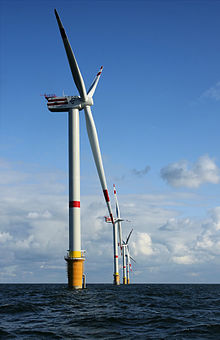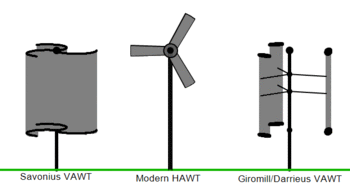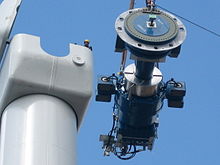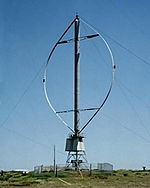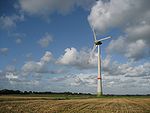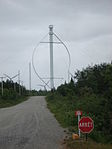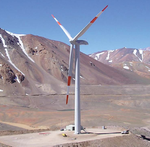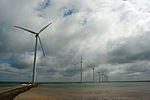- Wind turbine
-
- This article discusses wind-powered electrical generators. See windmill for wind-powered machinery used to grind grain or pump water.
A wind turbine is a device that converts kinetic energy from the wind into mechanical energy. If the mechanical energy is used to produce electricity, the device may be called a wind generator or wind charger. If the mechanical energy is used to drive machinery, such as for grinding grain or pumping water, the device is called a windmill or wind pump. Developed for over a millennium, today's wind turbines are manufactured in a range of vertical and horizontal axis types. The smallest turbines are used for applications such as battery charging or auxiliary power on sailing boats; while large grid-connected arrays of turbines are becoming an increasingly large source of commercial electric power.
Contents
History
Main article: History of wind powerWindmills were used in Persia (present-day Iran) as early as 200 B.C.[1] The windwheel of Heron of Alexandria marks one of the first known instances of wind powering a machine in history.[2][3] However, the first known practical windmills were built in Sistan, a region between Afghanistan and Iran, from the 7th century. These "Panemone" were vertical axle windmills, which had long vertical driveshafts with rectangular blades.[4] Made of six to twelve sails covered in reed matting or cloth material, these windmills were used to grind grain or draw up water, and were used in the gristmilling and sugarcane industries.[5]
Windmills first appeared in Europe during the middle ages. The first historical records of their use in England date to the 11th or 12th centuries and there are reports of German crusaders taking their windmill-making skills to Syria around 1190.[6] By the 14th century, Dutch windmills were in use to drain areas of the Rhine delta.
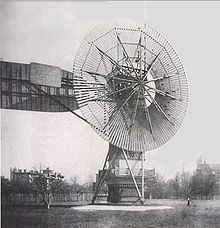 The first automatically operated wind turbine, built in Cleveland in 1887 by Charles F. Brush. It was 60 feet (18 m) tall, weighed 4 tons (3.6 metric tonnes) and powered a 12kW generator.[7]
The first automatically operated wind turbine, built in Cleveland in 1887 by Charles F. Brush. It was 60 feet (18 m) tall, weighed 4 tons (3.6 metric tonnes) and powered a 12kW generator.[7]
The first electricity generating wind turbine, was a battery charging machine installed in July 1887 by Scottish academic James Blyth to light his holiday home in Marykirk, Scotland.[8] Some months later American inventor Charles F Brush built the first automatically operated wind turbine for electricity production in Cleveland, Ohio.[8] Although Blyth's turbine was considered uneconomical in the United Kingdom[8] electricity generation by wind turbines was more cost effective in countries with widely scattered populations.[6] In Denmark by 1900, there were about 2500 windmills for mechanical loads such as pumps and mills, producing an estimated combined peak power of about 30 MW. The largest machines were on 24-metre (79 ft) towers with four-bladed 23-metre (75 ft) diameter rotors. By 1908 there were 72 wind-driven electric generators operating in the US from 5 kW to 25 kW. Around the time of World War I, American windmill makers were producing 100,000 farm windmills each year, mostly for water-pumping.[9] By the 1930s, wind generators for electricity were common on farms, mostly in the United States where distribution systems had not yet been installed. In this period, high-tensile steel was cheap, and the generators were placed atop prefabricated open steel lattice towers.
A forerunner of modern horizontal-axis wind generators was in service at Yalta, USSR in 1931. This was a 100 kW generator on a 30-metre (98 ft) tower, connected to the local 6.3 kV distribution system. It was reported to have an annual capacity factor of 32 per cent, not much different from current wind machines.[10] In the fall of 1941, the first megawatt-class wind turbine was synchronized to a utility grid in Vermont. The Smith-Putnam wind turbine only ran for 1,100 hours before suffering a critical failure. The unit was not repaired because of shortage of materials during the war.
The first utility grid-connected wind turbine to operate in the U.K. was built by John Brown & Company in 1951 in the Orkney Islands.[8][11]
Resources
Main article: Wind powerA quantitative measure of the wind energy available at any location is called the Wind Power Density (WPD) It is a calculation of the mean annual power available per square meter of swept area of a turbine, and is tabulated for different heights above ground. Calculation of wind power density includes the effect of wind velocity and air density. Color-coded maps are prepared for a particular area described, for example, as "Mean Annual Power Density at 50 Meters." In the United States, the results of the above calculation are included in an index developed by the U.S. National Renewable Energy Lab and referred to as "NREL CLASS." The larger the WPD calculation, the higher it is rated by class. Classes range from Class 1 (200 watts/square meter or less at 50 meters altitude) to Class 7 (800 to 2000 watts/square meter). Commercial wind farms generally are sited in Class 3 or higher areas, although isolated points in an otherwise Class 1 area may be practical to exploit.[12]
Types
Wind turbines can rotate about either a horizontal or a vertical axis, the former being both older and more common.[13]
Horizontal axis
Horizontal-axis wind turbines (HAWT) have the main rotor shaft and electrical generator at the top of a tower, and must be pointed into the wind. Small turbines are pointed by a simple wind vane, while large turbines generally use a wind sensor coupled with a servo motor. Most have a gearbox, which turns the slow rotation of the blades into a quicker rotation that is more suitable to drive an electrical generator.[14]
Since a tower produces turbulence behind it, the turbine is usually positioned upwind of its supporting tower. Turbine blades are made stiff to prevent the blades from being pushed into the tower by high winds. Additionally, the blades are placed a considerable distance in front of the tower and are sometimes tilted forward into the wind a small amount.
Downwind machines have been built, despite the problem of turbulence (mast wake), because they don't need an additional mechanism for keeping them in line with the wind, and because in high winds the blades can be allowed to bend which reduces their swept area and thus their wind resistance. Since cyclical (that is repetitive) turbulence may lead to fatigue failures, most HAWTs are of upwind design.
- Modern wind turbines
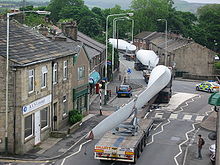 Turbine blade convoy passing through Edenfield in the UK
Turbine blade convoy passing through Edenfield in the UK
Turbines used in wind farms for commercial production of electric power are usually three-bladed and pointed into the wind by computer-controlled motors. These have high tip speeds of over 320 kilometres per hour (200 mph), high efficiency, and low torque ripple, which contribute to good reliability. The blades are usually colored light gray to blend in with the clouds and range in length from 20 to 40 metres (66 to 130 ft) or more. The tubular steel towers range from 60 to 90 metres (200 to 300 ft) tall. The blades rotate at 10-22 revolutions per minute. At 22 rotations per minute the tip speed exceeds 90 metres per second (300 ft/s).[15][16] A gear box is commonly used for stepping up the speed of the generator, although designs may also use direct drive of an annular generator. Some models operate at constant speed, but more energy can be collected by variable-speed turbines which use a solid-state power converter to interface to the transmission system. All turbines are equipped with protective features to avoid damage at high wind speeds, by feathering the blades into the wind which ceases their rotation, supplemented by brakes.
Vertical axis design
Vertical-axis wind turbines (or VAWTs) have the main rotor shaft arranged vertically. Key advantages of this arrangement are that the turbine does not need to be pointed into the wind to be effective. This is an advantage on sites where the wind direction is highly variable, for example when integrated into buildings. The key disadvantages include the low rotational speed with the consequential higher torque and hence higher cost of the drive train, the inherently lower power coefficient, the 360 degree rotation of the aerofoil within the wind flow during each cycle and hence the highly dynamic loading on the blade, the pulsating torque generated by some rotor designs on the drive train, and the difficulty of modelling the wind flow accurately and hence the challenges of analysing and designing the rotor prior to fabricating a prototype[17].
With a vertical axis, the generator and gearbox can be placed near the ground, using a direct drive from the rotor assembly to the ground-based gearbox, hence improving accessibility for maintenance.
When a turbine is mounted on a rooftop, the building generally redirects wind over the roof and this can double the wind speed at the turbine. If the height of the rooftop mounted turbine tower is approximately 50% of the building height, this is near the optimum for maximum wind energy and minimum wind turbulence. It should be borne in mind that wind speeds within the built environment are generally much lower than at exposed rural sites.[18]
Another type of vertical axis is the Parallel turbine similar to the crossflow fan or centrifugal fan it uses the Ground effect. Vertical axis turbines of this type have been tried for many years[19] The Magenn WindKite blimp uses this configuration as well, chosen because of the ease of running[20].
Subtypes
- Darrieus wind turbine
- "Eggbeater" turbines, or Darrieus turbines, were named after the French inventor, Georges Darrieus.[21] They have good efficiency, but produce large torque ripple and cyclical stress on the tower, which contributes to poor reliability. They also generally require some external power source, or an additional Savonius rotor to start turning, because the starting torque is very low. The torque ripple is reduced by using three or more blades which results in greater solidity of the rotor. Solidity is measured by blade area divided by the rotor area. Newer Darrieus type turbines are not held up by guy-wires but have an external superstructure connected to the top bearing.[22]
- Giromill
- A subtype of Darrieus turbine with straight, as opposed to curved, blades. The cycloturbine variety has variable pitch to reduce the torque pulsation and is self-starting.[23] The advantages of variable pitch are: high starting torque; a wide, relatively flat torque curve; a lower blade speed ratio; a higher coefficient of performance; more efficient operation in turbulent winds; and a lower blade speed ratio which lowers blade bending stresses. Straight, V, or curved blades may be used.[24]
- Savonius wind turbine
- These are drag-type devices with two (or more) scoops that are used in anemometers, Flettner vents (commonly seen on bus and van roofs), and in some high-reliability low-efficiency power turbines. They are always self-starting if there are at least three scoops.
- Twisted Savonius
- Twisted Savonius is a modified savonius, with long helical scoops to give a smooth torque, this is mostly used as roof windturbine or on some boats (like the Hornblower Hybrid).
Turbine design and construction
Main article: Wind turbine designWind turbines are designed to exploit the wind energy that exists at a location. Aerodynamic modelling is used to determine the optimum tower height, control systems, number of blades and blade shape.
Wind turbines convert wind energy to electricity for distribution. Conventional horizontal axis turbines can be divided into three components.
- The rotor component, which is approximately 20% of the wind turbine cost, includes the blades for converting wind energy to low speed rotational energy.
- The generator component, which is approximately 34% of the wind turbine cost, includes the electrical generator, the control electronics, and most likely a gearbox (e.g. planetary gearbox,[25] adjustable-speed drive [26] or continuously variable transmission[27]) component for converting the low speed incoming rotation to high speed rotation suitable for generating electricity.
- The structural support component, which is approximately 15% of the wind turbine cost, includes the tower and rotor yaw mechanism.[28]
A 1.5 MW wind turbine of a type frequently seen in the United States has a tower 80 meters high. The rotor assembly (blades and hub) weighs 48,000 pounds (22,000 kg). The nacelle, which contains the generator component, weighs 115,000 pounds (52,000 kg). The concrete base for the tower is constructed using 58,000 pounds (26,000 kg) of reinforcing steel and contains 250 cubic yards (190 cubic meters) of concrete. The base is 50 feet (15 m) in diameter and 8 feet (2.4 m) thick near the center.[29]
Unconventional wind turbines
Main article: Unconventional wind turbinesOne E-66 wind turbine at Windpark Holtriem, Germany, carries an observation deck, open for visitors. Another turbine of the same type, with an observation deck, is located in Swaffham, England. Airborne wind turbines have been investigated many times but have yet to produce significant energy. Conceptually, wind turbines may also be used in conjunction with a large vertical solar updraft tower to extract the energy due to air heated by the sun.
Wind turbines which utilise the Magnus effect have been developed.[2]
The Ram air turbine is a specialist form of small turbine that is fitted to some aircraft. When deployed, the RAT is spun by the airstream going past the aircraft and can provide power for the most essential systems if there is a loss of all on–board electrical power.
Small wind turbines
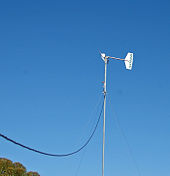 A small wind turbine being used in Australia
A small wind turbine being used in Australia Main article: Small wind turbine
Main article: Small wind turbineSmall wind turbines may be as small as a fifty-watt generator for boat or caravan use. The US Department of Energy's National Renewable Energy Laboratory (NREL) defines small wind turbines as those smaller than or equal to 100 kilowatts.[30] Small units often have direct drive generators, direct current output, aeroelastic blades, lifetime bearings and use a vane to point into the wind.
Larger, more costly turbines generally have geared power trains, alternating current output, flaps and are actively pointed into the wind. Direct drive generators and aeroelastic blades for large wind turbines are being researched.
Wind turbine spacing
On most horizontal windturbine farms, a spacing of about 6-10 times the rotor diameter is often upheld. However, for large wind farms distances of about 15 rotor diameters should be more economically optimal, taking into account typical wind turbine and land costs. This conclusion has been reached by research[31] conducted by Charles Meneveau of the Johns Hopkins University[32] and Johan Meyers of Leuven University in Belgium, based on computer simulations[33] that take into account the detailed interactions among wind turbines (wakes) as well as with the entire turbulent atmospheric boundary layer. Moreover, recent research by John Dabiri of Caltech suggests that vertical wind turbines may be placed much more closely together so long as an alternating pattern of rotation is created allowing blades of neighboring turbines to move in the same direction as they approach one another [34].
Accidents
Several cases occurred where the housing of wind turbines caught fire. As it is normally out of the range of standard fire extinction equipment, it is nearly impossible to extinguish such fires. In several cases one or more blades were damaged or torn away.[35] In 2010 70 MPH storm winds damaged some blades, prompting blade removal and inspection of all 25 wind turbines in Campo Indian Reservation in California, USA.[36] Also several wind turbines collapsed catastrophically.
Place Date Type Height of nacelle Rotor diametre Year of construction Reason Source Remarks Ellenstedt, Germany October 19, 2002 [3] Schneebergerhof, Germany December 20, 2003 Vestas V80 80 m [4] Wasco, Oregon, USA August 26, 2007 [5] 1 killed, 1 injured Stobart Mill, UK December 30, 2007 Vestas 1982 [6] Hornslet, Denmark February 22, 2008 Nordtank NKT 600-180 44.5 m 43 m 1996 Brake failure [7] Collapse was filmed [8] Searsburg, New Hampshire, USA October 16, 2008 Zond Z-P40-FS 1997 Rotor blade collided with tower during strong wind and destroyed it [9] Altona, New York, USA March 6, 2009 [10] Fenner, New York, USA December 27, 2009 [11] Kirtorf, Germany June 19, 2011 DeWind D-6 68.5 m 62 m 2001 [12] Record-holding turbines
Largest capacity
The Enercon E-126 has a rated capacity of 7.58 MW,[37] has an overall height of 198 m (650 ft), a diameter of 126 m (413 ft), and is the world's largest-capacity wind turbine since its introduction in 2007.[38]
At least four companies are working on the development of a 10MW turbine:
- American Superconductor[39]
- Wind Power Ltd are developing a 10 MW VAWT, the Aerogenerator X[40]
- Sway AS announced the proposed development of a prototype 10 MW wind turbine with a height of 162.5 m (533 ft) and a rotor diameter of 145 m (475 ft).[40][41][42]
- Astralux Ltd are developing vertical axis magneto levitated 10 MW turbine with 230 m height and 260 m rotor diameter[43][44]
- Clipper Windpower were developing the Britannia 10 MW HAWT, but terminated the project due to financial challenges.[39][40][41][45]
Largest swept area
The turbine with the largest swept area is a prototype installed by Gamesa at Jaulín, Zaragoza, Spain in 2009. The G10X – 4.5 MW has a rotor diameter of 128m. [46]
Tallest
The tallest wind turbine is Fuhrländer Wind Turbine Laasow. Its axis is 160 meters above ground and its rotor tips can reach a height of 205 meters. It is the only wind turbine in the world taller than 200 meters.[47]
Largest vertical-axis
Le Nordais wind farm in Cap-Chat, Quebec has a vertical axis wind turbine (VAWT) named Éole, which is the world's largest at 110 m.[48] It has a nameplate capacity of 3.8MW.[49]
Most southerly
The turbines currently operating closest to the South Pole are three Enercon E-33 in Antarctica, powering New Zealand's Scott Base and the United States' McMurdo Station since December 2009[50][51] although a modified HR3 turbine from Northern Power Systems operated at the Amundsen-Scott South Pole Station in 1997 and 1998.[52] In March 2010 CITEDEF designed, built and installed a wind turbine in Argentine Marambio Base.[53]
Most productive
Four turbines at Rønland wind farm in Denmark share the record for the most productive wind turbines, with each having generated 63.2 GWh by June 2010[54]
Highest-situated
The world's highest-situated wind turbine is made by DeWind installed by the Seawind Group and located in the Andes, Argentina around 4,100 metres (13,500 ft) above sea level. The site uses a type D8.2 - 2000 kW / 50 Hz turbine. This turbine has a new drive train concept with a special torque converter (WinDrive) made by Voith and a synchronous generator. The WKA was put into operation in December 2007 and has supplied the Veladero mine of Barrick Gold with electricity since then.[55]
Largest floating wind turbine
The world's largest—and also the first operational deep-water large-capacity—floating wind turbine is the 2.3 MW Hywind currently operating 10 kilometres (6.2 mi) offshore in 220-meter-deep water, southwest of Karmøy, Norway. The turbine began operating in September 2009 and utilizes a Siemens 2.3 MW turbine[56][57]
Gallery of record-holders
-
Éole, the largest vertical axis wind turbine, in Cap-Chat, Quebec
-
Highest-situated wind turbine, at the Veladero mine in San Juan Province, Argentina
-
Rønland, most productive turbines, in Denmark
See also
- American Wind Energy Association
- Atmospheric icing
- Balancing machine
- Compact wind acceleration turbine
- Environmental concerns with electricity generation
- Environmental effects of wind power
- Éolienne Bollée
- Floating wind turbine
- GE 1.5 MW wind turbine
- Green energy
- High altitude wind power
- Hybrid power source
- Lists of wind farms by country
- List of wind turbine manufacturers
- List of wind turbines
- Maglev wind turbine
- Microgeneration
- Ram air turbine
- Renewable energy
- Thomas O. Perry
- Turbine
- Wind farm
- Wind lens
- Wind run
- Wind turbines (UK domestic)
- Windbelt
- Windpump
References
- ^ "Part 1 — Early History Through 1875". http://www.telosnet.com/wind/early.html. Retrieved 2008-07-31.
- ^ A.G. Drachmann, "Heron's Windmill", Centaurus, 7 (1961), pp. 145–151
- ^ Dietrich Lohrmann, "Von der östlichen zur westlichen Windmühle", Archiv für Kulturgeschichte, Vol. 77, Issue 1 (1995), pp. 1–30 (10f.)
- ^ Ahmad Y Hassan, Donald Routledge Hill (1986). Islamic Technology: An illustrated history, p. 54. Cambridge University Press. ISBN 0-521-42239-6.
- ^ Donald Routledge Hill, "Mechanical Engineering in the Medieval Near East", Scientific American, May 1991, p. 64-69. (cf. Donald Routledge Hill, Mechanical Engineering)
- ^ a b Morthorst, Poul Erik; Redlinger, Robert Y.; Andersen, Per (2002). Wind energy in the 21st century: economics, policy, technology and the changing electricity industry. Houndmills, Basingstoke, Hampshire: Palgrave/UNEP. ISBN 0-333-79248-3.
- ^ A Wind Energy Pioneer: Charles F. Brush. Danish Wind Industry Association. http://www.windpower.org/en/pictures/brush.htm. Retrieved 2008-12-28.
- ^ a b c d "James Blyth". Oxford Dictionary of National Biography. Oxford University Press. http://www.oxforddnb.com/public/dnb/100957.html. Retrieved 2009-10-09.
- ^ Quirky old-style contraptions make water from wind on the mesas of West Texas
- ^ Alan Wyatt: Electric Power: Challenges and Choices. Book Press Ltd., Toronto 1986, ISBN 0-920650-00-7
- ^ Anon. "Costa Head Experimental Wind Turbine". orkney Sustainable Energy Website. Orkney Sustainable Energy Ltd. http://www.orkneywind.co.uk/costa.html. Retrieved 19 December 2010.
- ^ http://www.nrel.gov/gis/wind.html Dynamic Maps, GIS Data and Tools
- ^ "Wind Energy Basics". American Wind Energy Association. http://www.awea.org/faq/wwt_basics.html. Retrieved 2009-09-24.[dead link]
- ^ http://www.windpower.org/en/tour/wtrb/comp/index.htm Wind turbine components retrieved November 8, 2008
- ^ <</en/15mw/specs.htm 1.5 MW Wind Turbine Technical Specifications
- ^ Size specifications of common industrial wind turbines
- ^ About the wind flow modeling uncertainty at the AWS Open-Wind website
- ^ About urban vs. rural wind speeds with actual readings. See also Urban wind turbines tech analysis
- ^ A large unit producing up to 10 kW was built by Israeli wind pioneer Bruce Brill in the 1980's. See his patent. (The device is mentioned in Dr. Moshe Dan Hirsch's 1990 report, which decided the Israeli energy department investments and support in the next 20 years)
- ^ a blog with several images of different horizontal parallel turbine concepts
- ^ http://www.symscape.com/blog/vertical_axis_wind_turbine
- ^ Exploit Nature-Renewable Energy Technologies by Gurmit Singh, Aditya Books, pp 378
- ^ http://www.awea.org/faq/vawt.html
- ^ About blade stress and bending at the Springer Publishing website
- ^ Hansen Industrial Transmissions W4
- ^ Adjustable speed drive used on wind turbines
- ^ Continuously variable transmission for wind turbines
- ^ "Wind Turbine Design Cost and Scaling Model," Technical Report NREL/TP-500-40566, December, 2006, page 35,36. http://www.nrel.gov/docs/fy07osti/40566.pdf
- ^ [1]
- ^ http://www.nrel.gov/wind/smallwind/
- ^ J. Meyers and C. Meneveau, "Optimal turbine spacing in fully developed wind farm boundary layers" (2011), Wind Energy DOI: 10.1002/we.469
- ^ Optimal spacing for wind turbines
- ^ M. Calaf, C. Meneveau and J. Meyers, "Large Eddy Simulation study of fully developed wind-turbine array boundary layers" (2010), Phys. Fluids 22, 015110
- ^ Dabiri, J. Potential order-of-magnitude enhancement of wind farm power density via counter-rotating vertical-axis wind turbine arrays (2011), J. Renewable Sustainable Energy 3, 043104
- ^ www.windbyte.co.uk
- ^ www.signonsandiego.com
- ^ http://www.enercon.de/p/downloads/EN_Produktuebersicht_0710.pdf
- ^ "New Record: World’s Largest Wind Turbine (7+ Megawatts) — MetaEfficient Reviews". MetaEfficient.com. 2008-02-03. http://www.metaefficient.com/news/new-record-worlds-largest-wind-turbine-7-megawatts.html. Retrieved 2010-04-17.
- ^ a b "Wind Turbines go Super-Sized". Energy Efficiency & Technology. 2009-09-01. http://eetweb.com/wind/wind-turbines-go-supersized-20091001/. Retrieved 2010-07-26.
- ^ a b c Vidal, John (2010-07-26). "Engineers race to design world's biggest offshore wind turbines". The Guardian. http://www.guardian.co.uk/environment/2010/jul/26/offshore-turbine-britain. Retrieved 2010-07-26.
- ^ a b "Offshore wind turbines may be 10 MW giants: Veritas". Reuters. 2010-03-29. http://www.reuters.com/article/idUSTRE62S2ZP20100329. Retrieved 2010-07-26.
- ^ http://www.google.com/hostednews/afp/article/ALeqM5j-BZEK4lR-_hxsz2hQ-92_c0oSHQ Retrieved 2010-02-13
- ^ "10MW Wind Turbine Quadruples Power". Property Magazine. 2011-05-18. http://pptymag.com/10mw-wind-turbine-quadruples-power/4730/. Retrieved 2011-06-28.
- ^ "10 MW Vertical Axis Wind Turbine". Astralux Website. 2011-06-28. http://newwindturbine.com/wind-turbines/10-mw-wind-turbine/. Retrieved 2011-06-28.
- ^ http://www.nawindpower.com/e107_plugins/content/content.php?content.8467
- ^ "Gamesa Presents G10X-4.5 MW Wind Turbine Prototype". http://www.renewable-energy-sources.com/2009/06/29/gamesa-presents-g10x-4-5-mw-wind-turbine-prototype/. Retrieved 2010-07-26.
- ^ "FL 2500 Noch mehr Wirtschaftlichkeit" (in German). Fuhrlaender AG. http://fuhrlaender.de/produkte/index_de.php?produkt_gesucht=1&produkt_name=FL+2500. Retrieved 2009-11-05.
- ^ "Visits > Big wind turbine". http://www.eolecapchat.com/e_1b-grande.html. Retrieved 2010-04-17.
- ^ "Wind Energy Power Plants in Canada - other provinces". 2010-06-05. http://www.industcards.com/wind-canada.htm. Retrieved 2010-08-24.
- ^ Antarctica New Zealand
- ^ New Zealand Wind Energy Association
- ^ Bill Spindler, The first Pole wind turbine.
- ^ GENERADOR DE ENERGÍA EÓLICA EN LA ANTÁRTIDA
- ^ "Surpassing Matilda: record-breaking Danish wind turbines". http://www.energynumbers.info/surpassing-matilda-record-breaking-danish-wind-turbines. Retrieved 2010-07-26.
- ^ http://www.voithturbo.com/vt_en_pua_windrive_project-report_2008.htm
- ^ Patel, Prachi (2009-06-22). "Floating Wind Turbines to Be Tested". IEEE Spectrum. http://www.spectrum.ieee.org/green-tech/wind/floating-wind-turbines-to-be-tested. Retrieved 2011-03-07. "will test how the 2.3-megawatt turbine holds up in 220-meter-deep water."
- ^ Madslien, Jorn (8 September 2009). "Floating challenge for offshore wind turbine". BBC News (BBC). http://news.bbc.co.uk/2/hi/8235456.stm?ls. Retrieved 2011-03-07. "world's first full-scale floating wind turbine"
Further reading
- Tony Burton, David Sharpe, Nick Jenkins, Ervin Bossanyi: Wind Energy Handbook, John Wiley & Sons, 1st edition (2001), ISBN 0-471-48997-2
- Darrell, Dodge, Early History Through 1875, TeloNet Web Development, Copyright 1996–2001
- David, Macaulay, New Way Things Work, Houghton Mifflin Company, Boston, Copyright 1994–1999, pg.41-42
- Erich Hau Wind turbines: fundamentals, technologies, application, economics Birkhäuser, 2006 ISBN 3540242406 (preview on Google Books)
- David Spera (ed,) Wind Turbine Technology: Fundamental Concepts in Wind Turbine Engineering, Second Edition (2009), ASME Press, ISBN #: 9780791802601
External links
- Harvesting the Wind (45 lectures about wind turbines by professor Magdi Ragheb
- Time-lapse video of wind turbine installation at the WMRA Deer Island Wastewater Treatment Plant
- Wind Projects
- Guided tour on wind energy
- Wind Energy Technology World Wind Energy Association
- Wind turbine simulation, National Geographic
- Airborne Wind Industry Association international
Wind power Wind power - Environmental effects
- History
- Vehicles
- Offshore wind power
- Wind turbine
- Windmill
- Kitegen
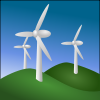
Wind power by country Wind turbines - Aerodynamics
- Airborne
- Darrieus
- Design
- Floating
- Savonius
- Quietrevolution
- Small
- Unconventional
- Vertical axis
- Devices in use
Wind power industry - Consultants
- Manufacturers
- Software
- Wind farm management
Wind farms - Community-owned
- List of offshore wind farms
- List of onshore wind farms
Concepts - Betz' law
- Capacity factor
- EROEI
- Grid energy storage
- HVDC
- Intermittency
- Net energy gain
- Storage
- Subsidies
- Wind power forecasting
- Wind profile power law
- Wind resource assessment
Categories:- Aerodynamics
- Electric power
- Electrical generators
- Electro mechanical engineering
- Energy conversion
- Wind turbines
Wikimedia Foundation. 2010.

